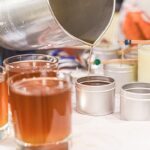Can Northern Bayberry Be Used in Candle Making? This is a question that has piqued the curiosity of many candle enthusiasts. In this article, we will delve into the world of candle making and discover the unique characteristics and benefits that Northern Bayberry brings to this craft.
Candles have long been a staple in creating ambiance, providing relaxation, and adding a touch of elegance to any space. However, using natural ingredients like Northern Bayberry takes candle making to a whole new level. With its distinct properties, this plant offers an exciting alternative to traditional waxes, captivating both seasoned candle makers and those new to the craft.
Northern Bayberry, also known by its botanical name Myrica pensylvanica, is an evergreen shrub native to North America. It boasts glossy green leaves and produces small berries that encase a hidden secret – bayberry wax. Traditionally used by early settlers for its medicinal qualities and decorative purposes, bayberry wax has become highly sought after by candle makers for its clean-burning properties and alluring fragrance.
With so much versatility at its core, exploring the use of Northern Bayberry in candle making opens up endless possibilities for creative expression. Whether you choose to create candles for your personal enjoyment or as unique gifts for loved ones, incorporating bayberry wax can elevate your creations to truly unforgettable pieces of art.
Join us as we embark on this journey through the world of Northern Bayberry candles. From understanding the plant’s history and cultural significance to discovering techniques for effective incorporation, our comprehensive guide will equip you with knowledge and inspiration to unlock the timeless charm of these exquisite candles.
Understanding Northern Bayberry
Northern Bayberry, also known by its botanical name Myrica pensylvanica, is a versatile plant that has gained popularity in candle making due to its unique characteristics. Native to North America, this hardy shrub can be found along coastlines and in sandy areas. Northern Bayberry is known for its glossy green leaves, which emit a pleasant fragrance when crushed. The plant produces small, waxy berries that are the key ingredient in extracting Bayberry Wax.
The Northern Bayberry plant is typically 3 to 10 feet tall and has a dense growth habit with multiple trunks emerging from the base. Its leaves are leathery and lance-shaped, measuring around 1-3 inches long. The plant features clusters of small inconspicuous flowers that bloom in the spring and eventually develop into the clusters of berries for which it is well-known.
Historically, Northern Bayberry has held cultural significance and has been used for a variety of purposes beyond candle making. Indigenous tribes used its branches in ceremonial events and constructed baskets from its twigs. Additionally, the root bark extract was commonly used as an herbal remedy for various ailments including stomach issues and fevers. The berries themselves were also utilized as a natural dye for fabrics, creating shades ranging from grey to yellow.
Furthermore, Northern Bayberry played an important role during colonial times when traditional candle-making methods were practiced. The rendered wax obtained from its berries – known as Bayberry Wax – was often used as an alternative to more expensive beeswax or tallow. This wax had excellent adhesive properties and burned clean without producing smoke or soot, making it ideal for high-quality candles.
Understanding the rich history and versatility of Northern Bayberry helps us appreciate its significance not only in candle making but also in cultural traditions and other areas of daily life. Whether you are interested in exploring herbal remedies or simply looking to create unique handmade candles, the Northern Bayberry plant offers a world of possibilities.
Traditional Uses of Northern Bayberry
Northern Bayberry is a versatile plant that has been used for much more than candle making throughout history. This section will delve into the various traditional uses of Northern Bayberry, including its medicinal, culinary, and decorative purposes. Additionally, we will explore any folklore or indigenous practices associated with this remarkable plant.
Medicinal Uses
One of the traditional uses of Northern Bayberry is in the field of medicine. The leaves and bark of the plant have long been used in the creation of herbal remedies. Native Americans valued Northern Bayberry for its astringent properties and used it to treat various illnesses, such as diarrhea, dysentery, and sore throats.
The leaves were often brewed into a tea or poultice to alleviate these ailments. Additionally, the bark was believed to have antispasmodic properties and was utilized as a natural remedy for cramps and menstrual pain.
Culinary Delights
In addition to its medicinal uses, Northern Bayberry also found its way into the culinary world. Historically, the berries were harvested and used in recipes that called for tart or tangy flavors. The berries added a unique taste to jams, jellies, sauces, and even beverages. Some cultures incorporated Northern Bayberry into their traditional dishes as well. For instance, Native American tribes would mix bayberries with other fruits like blueberries to create flavorful desserts.
Decorative Purposes
Furthermore, Northern Bayberry has played a role in various decorative practices throughout history. The branches of this plant are known for their attractive shiny leaves, which remain green even during winter months. These branches were commonly used in wreaths and garlands during festive seasons such as Christmas and New Year’s celebrations. In some cultures, these decorative elements were believed to bring good luck and ward off evil spirits.
The traditional uses of Northern Bayberry extend far beyond candle making. This versatile plant has a rich history of being utilized for medicinal purposes, culinary delights, and decorative practices. Exploring the traditional uses of Northern Bayberry can provide a deeper understanding of this remarkable plant and its significance in different cultures and traditions.
Extracting Bayberry Wax
One of the key aspects that sets Northern Bayberry apart in candle making is the process of extracting its wax. The extraction of Bayberry Wax is a labor-intensive and time-consuming process, which adds to its value as a natural ingredient in candle production. This section will delve into the intricacies of this unique extraction method and highlight the yield, properties, and quality of Bayberry Wax obtained from Northern Bayberry berries.
To obtain Bayberry Wax, the berries from the Northern Bayberry plant must first be gathered. These berries are then allowed to ripen before being harvested, usually in late autumn or early winter when they contain a higher wax content. The traditional method of extracting the wax involves boiling these berries to release their natural oils and waxes.
As they simmer, the wax rises to the surface and solidifies upon cooling, forming a layer that can be carefully removed. This raw Bayberry Wax is then further refined through processes such as filtering or clarifying to remove impurities and enhance its quality.
The yield of Bayberry Wax extracted from Northern Bayberry berries is relatively low compared to other waxes commonly used in candle making. It takes approximately 15 pounds (6.8 kilograms) of bayberries to produce just one pound (0.45 kilograms) of wax. However, despite its limited availability, many candle makers cherish the unique properties this wax offers.
Bayberry Wax has a distinctive greenish color and a naturally pleasant scent attributed to its botanical origins. It has a high melting point, which contributes to slower burning candles with less dripping or soot formation compared to candles made with conventional waxes. Furthermore, Bayberry Wax has been known for its long-lasting qualities, allowing candles made with this wax to provide hours of aromatic enjoyment.
Incorporating Northern Bayberry contributes not only to producing eco-friendly candles but also creates an opportunity to support sustainable practices. Due to the limited yield of Bayberry Wax, incorporating this unique ingredient in candle making can enhance the exclusivity and artisanal charm of the final product. Candle enthusiasts who appreciate the history, craftsmanship, and ecological benefits associated with Northern Bayberry wax may find great joy in creating their own candles using this precious ingredient.
The Advantages of Bayberry Wax
Bayberry wax, derived from the berries of the Northern Bayberry plant, offers many advantages that make it an excellent choice for candle making. Its unique characteristics and properties set it apart from conventional waxes and contribute to its growing popularity among candle makers.
One of the main advantages of Bayberry wax is its clean-burning properties. Unlike some petroleum-based waxes, Bayberry wax burns without emitting harmful toxins or soot. This makes it a healthier option for indoor use, especially for individuals with respiratory sensitivities or allergies. Additionally, clean-burning candles are more environmentally friendly as they do not contribute to air pollution.
Another advantage of Bayberry wax is its natural scent. The berries of the Northern Bayberry plant have a pleasant, subtle aroma that can enhance the ambiance of any space. When used in candle making, this natural scent is released slowly and evenly as the candle burns, creating a soothing atmosphere. Many people appreciate the authentic fragrance of Bayberry wax candles compared to artificially scented candles.
Additionally, Bayberry wax has long-lasting qualities that make it ideal for candle making. The wax has a higher melting point compared to other types of waxes, resulting in candles that burn at a slower rate and last longer. This means that Bayberry wax candles provide hours of enjoyment and relaxation before needing to be replaced.
| Clean-Burning | Natural Scent | Long-Lasting |
|---|---|---|
| Does not emit toxins or soot | Pleasant, subtle aroma | Burns at a slower rate |
| Environmentally friendly | Authentic fragrance | Provides hours of enjoyment |
Overall, Bayberry wax offers a unique combination of benefits that make it an appealing choice for candle making. Its clean-burning properties, natural scent, and long-lasting qualities contribute to a truly enjoyable and environmentally conscious candle experience. Whether used for personal enjoyment or as gifts, candles made with Bayberry wax are sure to impress with their timeless charm and allure.
Techniques for Incorporating Northern Bayberry in Candle Making
Northern Bayberry is a versatile and unique ingredient that can add a touch of natural elegance to your handmade candles. Incorporating this botanical wonder into your candle making process requires careful attention to detail and a bit of experimentation. In this section, we will explore step-by-step techniques for effectively incorporating Northern Bayberry and its wax in candle making, as well as provide tips and tricks to overcome any challenges that may arise.
- Harvesting the Berries: The first step in utilizing Northern Bayberry in candle making is to gather the berries from the plant. Typically, these berries are harvested in autumn when they are fully ripe and have turned dark purple or black. It’s important to handle them gently to avoid bruising or damaging the wax glands that coat each berry.
- Extracting the Wax: Once you have collected a sufficient amount of Northern Bayberry berries, it’s time to extract the wax. The traditional method involves boiling the berries and skimming off the floating wax, but this can be a labor-intensive process. Alternatively, you can freeze the berries overnight and then gently squeeze them by hand or use an industrial press to release the waxy coating.
- Filtering and Purifying: After extracting the wax, it’s crucial to filter and purify it before further use. This helps remove impurities such as dirt, plant debris, and residual moisture that may affect your candle’s quality. Straining the melted wax through cheesecloth or using a fine-mesh filter can help achieve this purification.
- Blending with Other Waxes: The extracted Northern Bayberry wax can be used on its own or blended with other waxes like soy wax or beeswax to create custom formulations suitable for different types of candles. Experiment with different ratios until you find a blend that suits your desired burn time, scent throw, and overall performance.
- Adding Fragrance and Color: If you wish to enhance the natural scent of Northern Bayberry or add a touch of color to your candles, this is the stage to incorporate fragrance oils or candle dye. It’s important to use candle-safe fragrance oils and dyes specifically formulated for wax to ensure both scent throw and the candle’s burn stability.
By following these techniques, you can successfully incorporate Northern Bayberry and its wax in your candle making process. Remember that practice makes perfect, so don’t be afraid to experiment and adjust your methods until you achieve the desired results. The versatility of Northern Bayberry allows for endless possibilities in creating unique and alluring candles.
Fragrance Combinations
When it comes to candle making, fragrance plays a crucial role in creating a captivating and inviting ambiance. While the natural scent of Northern Bayberry is already delightful on its own, combining it with other fragrances can take your candles to a whole new level. In this section, we will explore different fragrance combinations that complement the unique aroma of Northern Bayberry and inspire you to create your signature scents.
One popular option for enhancing the natural scent of Northern Bayberry is to blend it with citrus notes. The refreshing and uplifting qualities of citrus essential oils like lemon, orange, or grapefruit pair harmoniously with the earthy and slightly sweet aroma of Bayberry Wax. These combinations are particularly well-suited for energizing or invigorating atmospheres and are perfect for morning routines or workspaces.
For those seeking a more relaxing experience, consider combining Northern Bayberry with floral notes such as lavender, rose, or jasmine. These delicate and soothing scents beautifully complement the subtle herbal undertones of the Bayberry Wax, creating an atmosphere ideal for winding down after a long day or practicing self-care rituals.
Furthermore, if you’re looking to add warmth and depth to your Northern Bayberry candles, consider incorporating spicy or woody fragrances. Essential oils like cinnamon, clove, vanilla, or sandalwood can provide a cozy and comforting aroma when blended with Bayberry Wax. These combinations are perfect for creating an inviting ambiance during colder months or setting a cozy atmosphere during special occasions.
Showcasing Northern Bayberry Candle Creations
Northern Bayberry candles not only offer a unique and natural alternative to traditional wax candles, but they also provide an opportunity for creativity and personalization in candle making. The versatility of Northern Bayberry allows for a wide range of candle designs and uses that can suit various occasions and settings.
When it comes to designing Northern Bayberry candles, the possibilities are endless. One popular design choice is the use of clear glass containers, which showcase the beautiful green color of the Bayberry Wax. This simple yet elegant design is perfect for weddings or other formal events where a sophisticated touch is desired. For a more rustic and cozy look, consider using tin containers or mason jars, which add a charming farmhouse aesthetic to any space.
Another creative option when showcasing Northern Bayberry candles is incorporating different textures and elements into the candle itself. You can add dried herbs or flowers to give your candles a botanical feel, or even sprinkle some glitter on top for a touch of sparkle. Additionally, experimenting with different shapes and sizes, such as pillar candles or tea lights, can create visual interest and diversity in your candle collection.
In terms of uses, Northern Bayberry candles are not limited to simply providing light. Their natural scent makes them ideal for relaxation purposes. Consider creating a calming atmosphere in your home by placing Bayberry Wax tea lights in your bathroom or bedroom. Alternatively, you can use larger Bayberry Wax pillar candles as centerpieces during meditation sessions or yoga practices to enhance the overall experience.
Conclusion
In conclusion, Northern Bayberry is a natural ingredient that holds immense potential in the art of candle making. Throughout this article, we have explored the unique characteristics and benefits of Northern Bayberry, as well as its historical and cultural significance. We have also delved into the process of extracting Bayberry Wax from the berries of the Northern Bayberry plant and discussed its advantages over conventional waxes.
Bayberry Wax boasts clean-burning properties, a natural scent, and long-lasting qualities that make it an excellent choice for candle making. Its allure lies in its timeless charm, allowing candle makers to create creations that enhance any occasion or setting. Whether it be weddings, holiday décor, or moments of relaxation, Northern Bayberry candles bring a touch of elegance and style.
We encourage readers to embrace the versatility of Northern Bayberry and try their hand at creating their own unique Bayberry Wax candles. With step-by-step instructions provided in this article, along with tips and tricks to overcome any challenges they may encounter, readers can unleash their creativity and explore the endless possibilities offered by incorporating Northern Bayberry into their candle making projects.
So why not immerse yourself in the world of Northern Bayberry candles? Embrace the rich history and enchanting fragrance that this natural ingredient offers. Let your imagination soar as you design visually appealing candle creations and experiment with various fragrance combinations. Discover for yourself why Northern Bayberry is hailed as a timeless charm in the art of candle making.
Frequently Asked Questions
What are the rules for the bayberry candle?
The rules for the bayberry candle tradition are quite specific. According to folklore, the bayberry candle should only be lit on Christmas Eve and allowed to burn throughout the night until it has extinguished itself. It is believed that this ritual brings good luck and prosperity for the coming year.
In order to maintain the tradition, the candle must be made of at least 90% pure bayberry wax, as opposed to using other types of waxes or additives. The process of making these candles is labor-intensive, requiring a significant amount of bayberries to extract enough wax for a single candle.
What can you make from bay berries?
Bay berries offer various uses beyond just being used to make candles. One popular use is in culinary endeavors. These berries have a unique flavor profile with hints of citrus and spice, making them a sought-after ingredient for jams, jellies, syrups, and even baked goods like pies and tarts.
Additionally, bay berries can be infused into oils or used as seasoning in cooking due to their aromatic qualities. Some herbalists also utilize bay berries in medicinal preparations as they are thought to possess antiseptic and anti-inflammatory properties.
Why are bayberry candles hard to find?
Bayberry candles are often considered rare and hard to find due to several reasons. Firstly, as mentioned before, their production requires a substantial amount of bayberries to obtain sufficient wax, making them more expensive compared to other mass-produced candles available in the market. Moreover, gathering enough quantities of wild bayberries can be challenging as these shrubs thrive in specific regions and are not widely cultivated for commercial purposes.
Consequently, this limits the overall supply of bayberry wax and subsequently makes the finished candles less commonly available in stores or online retailers. As a result, individuals interested in purchasing bayberry candles may need to seek out specialty shops or artisans who produce them on a smaller scale or during the holiday season when demand tends to increase.

Welcome to my candle making blog! In this blog, I will be sharing my tips and tricks for making candles. I will also be sharing some of my favorite recipes.





